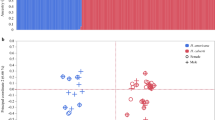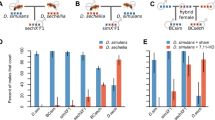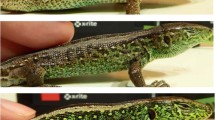Abstract
ALTERNATIVE male mating tactics are widespread among animal taxa1–3, but there are few well documented examples of genetic polymorphisms for them4–6. The dimorphism in male courtship behaviour between independent and satellite ruffs, Philomachm pugnax7,8 (a lekking sandpiper), has often been cited as a potential example but this has been questioned9,10 because of the lack of data11 and the widespread phenotypic plasticity in the development or expression of alternative tactics in other species1–3,9,12–14. By rearing ruffs in captivity, we now show that differential morph development is genetically controlled and consistent with a single-locus, two-allele autosomal genetic polymorphism. Several potentially relevant environmental factors do not appear to alter behavioural development.
This is a preview of subscription content, access via your institution
Access options
Subscribe to this journal
Receive 51 print issues and online access
$199.00 per year
only $3.90 per issue
Buy this article
- Purchase on Springer Link
- Instant access to full article PDF
Prices may be subject to local taxes which are calculated during checkout
Similar content being viewed by others
References
Dunbar, R. I. M. in Perspectives in Ethology Vol. 5 (eds Bateson, P. P. G. & Klopfer, P. H.) 385–431 (Plenum, New York, 1982).
Alcock, J. in Sexual Selection and Reproductive Competition in Insects (eds Blum, M. S. & Blum, N. A.) 381–402 (Academic, New York, 1979).
Arak, A. in Producers and Scroungers (ed. Barnard, C. J.) 154–194 (Croom Helm, London, 1984).
Zimmerer, E. J. & Kallman, K. D. Evolution 43, 1298–1307 (1989).
Ryan, M. J., Pease, C. M. & Morris, M. R. Am. Nat. 139, 21–31 (1992).
Erbelding-Denk, C. et al. Behav. Genet. 24, 95–101 (1994).
Hogan-Warburg, A. J. Ardea 54, 109–229 (1966).
van Rhijn, J. G. Behaviour 47, 153–229 (1973).
Caro, T. M. & Bateson, P. Anim. Behav. 34, 1483–1499 (1986).
Höglund, J. & Lundberg, A. Auk 106, 336–338 (1989).
van Rhijn, J. G. The Ruff (Poyser, London, 1991).
Dawkins, R. in Sociobiology: Beyond Nature/Nuture? (eds Barlow, G. W. & Silverberg, J.) 331–367 (Westview, Boulder, CO, 1980).
West-Eberhardt, M. J. A. Rev. Ecol. Syst. 20, 249–278 (1989).
Lively, C. M. Am. Nat. 128, 561–572 (1986).
van Rhijn, J. G. Ibis 125, 482–498 (1983).
Shepard, J. M. Living Bird 14, 87–111 (1985).
Hill, W. L. Behav. Ecol. Sociobiol. 29, 367–372 (1991).
Lank, D. B. & Smith, C. M. Behavl Ecol. Sociobiol. 29, 137–145 (1987).
Höglund, J., Montgomerie, R. & Widemo, F. Behavl Ecol. Sociobiol. 32, 31–39 (1993).
Slatkin, M. Am. Nat. 114, 384–398 (1989).
Austad, S. N. Am. Zool. 24, 309–320 (1984).
Maynard Smith, J. Evolution and the Theory of Games (Cambridge Univ. Press, 1982).
Cade, W. Science 212, 563–564 (1981).
Emlen, D.L. Proc. R. Soc. Lond. B256, 131–136 (1994).
Moran, N. A. Am. Nat. 139, 971–989 (1992).
Ricklefs, R. E. in Avian Biology Vol. 7 (eds Farner, D. S., King, J. R. & Parkes, K. C.) 1–83 (Academic, New York, 1983).
Hanotte, O., Burke, T., Armour, J. A. L. & Jeffreys, A. J. Genomics 9, 587–597 (1991).
Bruford, M. W., Hanotte, O., Brookfield, J. F. Y. & Burke, T. in Molecular Genetic Analysis of Populations: A Practical Approach (ed. Hoelzel, A. R.) 225–269 (IRL, Oxford, 1992).
Dixon, A., Ross, D., O'Malley, S. C. L. & Burke, T. Nature 371, 698–700 (1994).
Wong, Z., Wilson, V., Patel, I., Povey, S. & Jeffreys, A. J. Ann. hum. Genet. 51, 269–288.
Author information
Authors and Affiliations
Rights and permissions
About this article
Cite this article
Lank, D., Smith, C., Hanotte, O. et al. Genetic polymorphism for alternative mating behaviour in lekking male ruff Philomachus pugnax. Nature 378, 59–62 (1995). https://doi.org/10.1038/378059a0
Received:
Accepted:
Issue Date:
DOI: https://doi.org/10.1038/378059a0
This article is cited by
-
Sex-specific morphs: the genetics and evolution of intra-sexual variation
Nature Reviews Genetics (2023)
-
Bigger male Eurasian nuthatches (Sitta europaea) behave more aggressively in playback-simulated territorial intrusion
Journal of Ethology (2023)
-
Sexual selection on population-level mating opportunities drives morph ratios in a fig wasp with extreme male dimorphism
BMC Ecology and Evolution (2021)
-
Extreme Y chromosome polymorphism corresponds to five male reproductive morphs of a freshwater fish
Nature Ecology & Evolution (2021)
-
The role of genetic diversity in the evolution and maintenance of environmentally-cued, male alternative reproductive tactics
BMC Evolutionary Biology (2019)
Comments
By submitting a comment you agree to abide by our Terms and Community Guidelines. If you find something abusive or that does not comply with our terms or guidelines please flag it as inappropriate.



